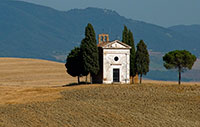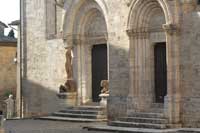Walking in Tuscany | Walk around Pienza | Montepulciano - Pienza |
| The Val d'Orcia refers to the valley of the river Orcia but in general it refers to the area extending from the hills south of Sienna as far as the Monte Amiata. The landscape in and around the Val d'Orcia is characterised by open vistas of ploughed and sown land that stretch over low hills to the horizon, punctuated here and there by clusters or rows of cypresses and umbrella pines. The crete senesi are areas of badlands that generations of farmers have brought into cultivation. The volcanic cone of Monte Amiata dominates the southern panorama. The territory of Val d’Orcia includes the entire surface of five municipalities, Castiglione d’Orcia, Montalcino, Pienza, Radicofani and San Quirico d’Orcia. Pienza and Montepulciano are within an hour's drive from Podere Santa Pia. Walking in Tuscany | Walk around Pienza |
| The trail starts on the Piazza Dante Alighieri in Pienza, and continues along the Viale Santa Caterina that leads to the Pieve di Corsignano, an exceptional example of Romanesque art just outside of the city walls of Pienza. Admire the carvings on the side of this ancient structure, which dates possibly from the 10th century. This was Pienza's original parish church. Follow the paved path beyond this beautiful Romanesque church, first along a derelict farm, then along the where you are right on a paved road to the intersection with the road San Quirico d'Orcia - Pienza. Walk in the direction of Pienza and turn right after about 10 minutes. The path runs downhill to Podere Arpicella. Turn left, and beyond a medieval tower, you can walk right back to Pienza (Viale Santa Caterina). Make time to visit the Romanesque Pieve di Corsignano, half a kilometre out of Pienza, along Via Fonti from Piazza Dante Alighieri. The Pieve di Corsignano dates from the 10th century and boasts a strange circular bell tower. There are no regular visiting times but the church is usually open. |
|
||
Halfway, the Strada Provinciale di Cosona leads to the Monastery of Sant'Anna in Camprena and Castelmuzio. One can recognize the Monastery of Sant'Anna in Camprena as the refuge of The English Patient, a serene Romanesque compound with a Renaissance chapel that houses a fresco by Pinturicchio. Santa Anna in Camprena is however not open for the public.
|
 Castelmuzio |
||
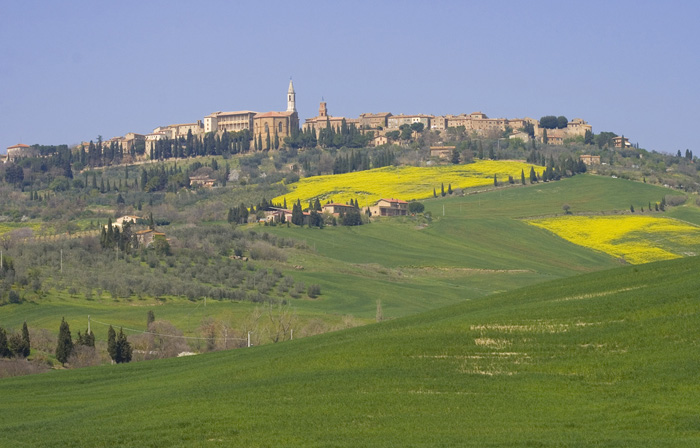 Pienza, a Renaissance hill town of exceptional beauty, Pienza is one of the gems of Tuscany and should on no account be missed by anyone visiting the Val d'Orcia. |
|||
Pienza, rebuilt in 1462 from a village called Corsignano, was intended to be an ideal Renaissance town. It represented the first application of urban planning concepts, creating an impetus for planning that was adopted in other Italian towns and cities and then eventually spread to other European centers. |
|||
| Montepulciano - Pienza | 11 km, 3 hours |
|||
| This walk is interesting for its varied landscape: from Montepulciano to Monticchiello you walk through countryside with olive groves, vineyards, walnut and fig trees and through typical Mediterranean woods, with holm oaks (evergreen oak Quercus Ilex), heather and broom. From Monticchiello to Pienza you walk on the balcony of the Val d'Orcia, a valley among beautiful rolling hills, framed by wheat fields, and occasional dark green pinnacles of cypress. From Piazza Grande, Via Ricci, Via dei Grassi and Via di San Biagio, walk down to San Biagio, which is situated at the bottom of the hill just outside the city walls. Considered to be Antonio da Sangallo the Elder's masterpiece and one of the most significant structures of the Renaissance, San Biagio occupied the acclaimed Renaissance architect from 1518 until his death in 1534, and although it maintains a low profile among guidebook tourists (much like Montepulciano itself), it's an absolute must-see. A dirt road takes us from the San Biagio church on the outskirts of Montichiello, a charming village immersed in the Crete Sienesi, and then further south to Pienza. The path is marked red and white. |
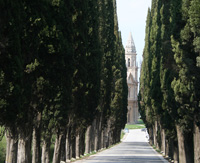 Madonna di San Biagio |
||
| Montefollonico is a small medieval village whose raison d'être is found in the past rivalries between the republics of Siena and Florence; in fact the village was born as a Sienese fortress, against the "Florentine" Montepulciano The hike from Montepulciano to Montefollonico takes about three hours. You exit Montepulciano by the old portal closest to St. Biagio church, walking down the hill toward St. Biagio. You walk just past the church on its left and then loop around the church to the right on a paved town road that becomes a paved country road.The entire walk offers great views on the stupendous Crete Senesi and its stunning scenery. Walking in Tuscany | Walking From Montepulciano to Montefollonico |
|||
Maps and descriptions available in Podere Santa Pia Kompass map 653 Pienza - Montalcino - Monte Amiata (1:50.000) |
|||
The territory of Val d’Orcia includes the entire surface of five municipalities, Castiglione d’Orcia, Montalcino, Pienza, Radicofani and San Quirico d’Orcia. |
|||
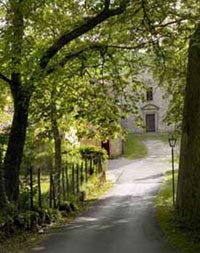 Borgo dell'Eremo and Chiesa di San Marcello |
|||||||||||||||||||||||||||||||||||||||||||||||
Vivo d'Orcia - Vivo d'Orcia Castelnuovo dell'Abate - Vivo d'Orcia The Castle of Vivo d'Orcia lies in the widespread Orcia valley in southern Tuscany, 35 km north of Podere Santa Pia. The area surrounding Montalcino has been famed for centuries by artists and poets for its beautiful yet peaceful landscapes, comprising of soft rolling valleys and lightly peppered with olive groves and vineyards of superior quality. Vivo d'Orcia is a splendid outlying district of Castiglion d'Orcia, set in a valley outside time. At the foot of the castle, the river Vivo runs whose sources rise in the locality of Ermicciolo. Starting in the middle ages flour-mills, paper-mills and ironworks were built along the torrent and, in the 1920’s, one of the first hydroelectric power stations. Traces of these old buildings, covered with climbing plants, may still be seen here in one of the area’s most beautiful and evocative landscapes. Maps and further descriptions are available in Podere Sante Pia. |
|||||||||||||||||||||||||||||||||||||||||||||||
|
|
|||||||||||||||||||||||||||||||||||||||||||||||
Hidden away from mass-tourism, discover a piece of Italy which remains largely unchanged both nature and lifestyle-wise. The peacefulness of the countryside, the various unique villages and the friendly atmosphere will no doubt pleasantly surprise you. Tuscany is one of the most popular tourist destinations in the world. Known for its enchanting landscapes, its fantastic and genuine food and beautiful towns as Florence, Pisa, Lucca and Siena. Its strategic location in southern Tuscany, serves as a perfect base to visit some of the most beautiful and fascinating attractions of the region: from Montalcino, Pienza, and Montepulciano in Val d’Orcia, to wonderful Tuscan hill towns like Massa Marrittima, Pitigliano, Sorano and Saturnia. Podere Santa Pia is a fully equipped 4 bedroom holiday home. The surrounding countryside is superbly peaceful with vineyards, olive groves, medieval hamlets and castles. Guests can sit in a South facing garden, surrounded by a marvelous natural landscape rich in beautiful hills, ancient villas, centuries-old olive groves, vineyards and hilltop villages with stone parish churches. This is the land where the DOC wines Montecucco, Vino Nobile di Montepulciano and Brunello di Montalcino are produced. So, the surrounding countryside is the ideal area for an uncommon wine tour, visiting small farms producing wine and excellent extra virgin olive oil. .If you want to spend an unforgettable holiday at Podere Santa Pia and visit these beautiful medieval castles and villages, visit our special offers page or contact us. |
|||||||||||||||||||||||||||||||||||||||||||||||
|
|||||||||||||||||||||||||||||||||||||||||||||||

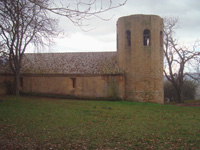 Pieve di Corsignano
Pieve di Corsignano 

